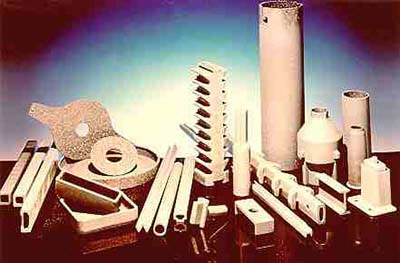Silicon Carbide (SiC)
Abstract
Silicon carbide (SiC) is a remarkable compound of carbon and silicon, initially produced through a high-temperature electrochemical reaction between sand and carbon. Its exceptional properties—including high-temperature strength, oxidation resistance, thermal shock resistance, and hardness—make it one of the most promising structural materials for diverse applications. SiC's superior performance stems from its unique atomic structure: tetrahedra of carbon and silicon atoms forming extremely strong bonds within the crystal lattice. This material has evolved from a simple abrasive to an advanced technical ceramic used in everything from grinding wheels to semiconductor components, with ongoing development expanding its structural and wear applications across multiple industries.
Introduction to Silicon Carbide
Silicon carbide (SiC) stands as one of the most promising structural materials for mechanical and thermomechanical applications. This exceptional compound—the only chemical combination of carbon and silicon—offers an impressive suite of properties: excellent high-temperature strength, superior oxidation resistance, exceptional thermal shock resistance, remarkable hardness, and low specific weight. Originally produced through a high-temperature electrochemical reaction of sand and carbon, SiC has evolved significantly since its discovery.
For over a century, silicon carbide has served as an excellent abrasive in grinding wheels and similar products. Today, it has developed into a high-quality technical ceramic with outstanding mechanical properties. Its applications span numerous fields, including abrasives, refractories, ceramics, and various high-performance uses. When processed appropriately, SiC can function as an electrical conductor, making it valuable for resistance heating, flame igniters, and electronic components. The development of structural and wear applications continues to expand, showcasing SiC's versatility.
Composition and Molecular Structure
The exceptional properties of silicon carbide derive from its fundamental atomic structure. The material consists of tetrahedra of carbon and silicon atoms forming extremely strong bonds within the crystal lattice. This arrangement creates a material with remarkable hardness and strength. The strong covalent bonds also contribute to SiC's chemical stability and resistance to extreme temperatures.
Silicon Carbide Production Methods
Silicon carbide is derived from powder or grain, produced through carbon reduction of silica. The initial product forms either as fine powder or as a large bonded mass that requires crushing. Purification involves washing with hydrofluoric acid to remove residual silica.
Commercial silicon carbide products are fabricated through three primary methods:
- Composite Formation: Mixing silicon carbide powder with another material such as glass or metal, followed by treatment to enable the second phase to bond.
- Reaction Bonding: Combining SiC powder with carbon or silicon metal powder to create a reaction-bonded product.
- Sintering Process: Densifying and sintering silicon carbide powder through the addition of boron carbide or other sintering aids.
Each production method suits different applications, allowing manufacturers to tailor SiC products to specific requirements.
Key Properties of Silicon Carbide
Silicon carbide exhibits numerous beneficial properties that make it ideal for demanding applications:
- Low density
- High strength
- Low thermal expansion coefficient
- High thermal conductivity
- Extreme hardness
- High elastic modulus
- Excellent thermal shock resistance
- Superior chemical inertness
- Semiconductor properties
- Refractive index greater than diamond
Table 1. Common values of Silicon Carbide properties
| Property | SI Units | Values |
| Physical/Mechanical | ||
| Density | g/m³ | 3.1 |
| Porosity | % | 0 |
| Color | - | Black |
| Flexural strength | MPa | 550 |
| Elastic Modulus | GPa | 410 |
| Shear Modulus | GPa | - |
| Bulk Modulus | GPa | - |
| Poisson’s ratio | - | 0.14 |
| Compressive strength | MPa | 3900 |
| Hardness | Kg/mm² | 2800 |
| Fracture toughness KIc | MPa·m1/2 | 4.6 |
| Max use temperature | °C | 1650 |
| Thermal Properties | ||
| Thermal Conductivity | W/m·K | 120 |
| Coefficient of Thermal Expansion | 10⁻⁶/°C | 4.0 |
| Specific heat | J/kg·K | 750 |
| Electrical | ||
| Volume Resistivity | Ohm·cm | 102 - 106 |
Silicon carbide's resistance to chemical attack is particularly notable. It remains unaffected by acids, alkalis, or molten salts up to 800°C. When exposed to air at 1200°C, SiC forms a protective silicon oxide coating, enabling use at temperatures up to 1600°C. The combination of high thermal conductivity with low thermal expansion and high strength gives this material exceptional thermal shock resistance.
Silicon carbide ceramics with minimal grain boundary impurities maintain their strength at extremely high temperatures, approaching 1600°C without degradation. This remarkable temperature stability makes SiC increasingly valuable for advanced applications.
Industrial and Technical Applications
The exceptional properties of silicon carbide have led to its adoption across numerous industries:
Semiconductor Industry
Chemical purity, resistance to chemical attack at elevated temperatures, and strength retention at high temperatures have made SiC popular for wafer tray supports and paddles in semiconductor furnaces.
Electrical Applications
The electrical conductivity of the material has led to its use in resistance heating elements for electric furnaces and as a key component in thermistors (temperature-variable resistors) and varistors (voltage-variable resistors).
Mechanical Components
Silicon carbide excels in applications requiring high performance under extreme conditions:
- Fixed and moving turbine components
- Suction box covers
- Seals and bearings
- Ball valve parts
- Hot gas flow liners
- Heat exchangers
- Semiconductor process equipment
Advanced Research Applications
Monolithic SiC ceramics and SiC-based ceramic composites show promise for thermonuclear fusion reactor applications. Silicon carbide fiber-reinforced composites offer particular advantages, including low radioactivity through neutron transmutations, high stability after reactor shutdown, excellent high-temperature properties, low plasma contamination, and low specific weight.

Figure 1: Silicon Carbide products
Conclusion
Silicon carbide continues to demonstrate its value as an advanced material for challenging applications. Its unique combination of properties—thermal resistance, chemical stability, mechanical strength, and electrical characteristics—ensures its ongoing importance in established and emerging technologies. As manufacturing techniques continue to advance, we can expect to see silicon carbide playing an increasingly vital role in high-performance applications across multiple industries.
¡Encuentre al Instante Propiedades Precisas de Materiales!
Total Materia Horizon contiene propiedades mecánicas y físicas de cientos de miles de materiales, para diferentes temperaturas, condiciones y tratamientos térmicos, y mucho más.

Obtenga una cuenta de prueba GRATUITA de Total Materia Horizon y únase a nuestra comunidad que traspasa los 500.000 usuarios provenientes de más de 120 países.